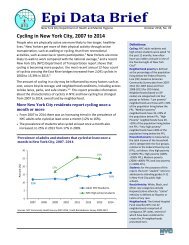2013-dot-sustainable-streets-lowres
2013-dot-sustainable-streets-lowres
2013-dot-sustainable-streets-lowres
Create successful ePaper yourself
Turn your PDF publications into a flip-book with our unique Google optimized e-Paper software.
RESILIENCYLooking AheadFor years environmental experts have been projecting thepossible catastrophic effects of increasingly volatile andextreme weather conditions on New York, but it wasn’t untilHurricane Sandy hit that the region experienced the magnitudeof these impacts first hand.The storm generated a sense of urgency around long–termresiliency and sustainability. The city pledged to redoubleenvironmental efforts outlined in PlaNYC to reduce greenhousegases that contribute to climate change. It also set in motionplans, procedures, and projects to adapt infrastructure andimprove government response to future events.In the immediate aftermath of the storm, NYCDOT workedclosely with other agencies to restore basic operations andassess the extent of the damage to the City’s transportationassets. The city’s use of bus bridges, for example, provedthat transit and roadway networks can be adapted quickly toemergency situations. The experience gave transportationofficials a template for future events and helped them refinea list of objectives to keep people moving in emergencysituations. These included immediately restricting single–occupant traffic as soon as long–term subway outagesare confirmed, creating temporary bus routes to replaceinoperative links of the transit network and adding capacityon existing bus routes with disaster–induced demand spikes,and exploiting redundant capacity in modes like ferries toscale up temporary service in disconnected areas. The spikein bicycle riding after the storm also prompted NYCDOT toevaluate additional bike facilities over the East River Bridges.As vehicular tunnels and subway lines returned to servicein the weeks following the storm, New York City’s transportationnetwork started to return to normal operations. However,many <strong>streets</strong> in the most vulnerable coastal areas remainedseverely damaged by the force of the storm. Creeping corrosionnecessitated repairs long after the actual floodwaters hadsubsided. In many locations, merely restoring agency assets(roadways, bridges, ferries, traffic controls) to its pre–Sandycondition is not enough. The transportation system needs tobe made more resilient in the face of storm surge, more intenseprecipitation, warmer temperatures, and stronger winds.Through the Mayor’s Special Initiative for Rebuilding andResilience (SIRR), NYCDOT and its partner agencies identifiedinnovative ways to rebuild smarter and stronger. A Stronger,More Resilient New York outlined 18 transportation initiativescentral to the City’s resiliency goals. In many areas, thechallenge is not merely the protection of a physical asset, butensuring that transportation network has the redundancy andflexibility to handle unforeseen outages. Continued expansionof bus rapid transit, for instance, not only benefits regularcommuters, it also broadens the transit network in ways thatcan better serve demands when a subway line is out of service.The report also called for larger transit expansion projects foradded redundancy, including Amtrak’s Gateway project intoPenn Station.All of these initiatives, most especially coastal protection, willrequire ongoing collaboration among city and state agencies.And they will require sustained, long–term investment duringa time of uncertain and shrinking funding for transportationinfrastructure.Sustainable Streets: <strong>2013</strong> Sustainable and Beyond Streets: <strong>2013</strong> and Beyond209



